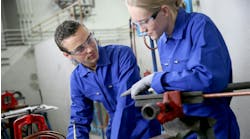Latest from Management
Sponsored
Compared to the cost of a new high-efficiency boiler, lots of things are relatively cheap. While it would be nice to sell a new boiler, there are easier and less expensive ways to reduce hydronic system energy usage. And if a new boiler is in the picture, it’s smart to consider these items to get even higher energy efficiency.
By definition, energy efficiency is the energy out (heat) divided by the energy in (fuel). Multiply the result by 100 and you have a percentage. The less energy you put in, or the more energy you get out, the higher the efficiency. And the less fuel cost to get the same amount of heat!
Combustion analysis
Most of the heat we create comes from burning fuel. This process, called combustion, is a matter of combining fuel and oxygen. If fuel and oxygen are in the right proportions, the process is efficient. If they are out of balance, heat can still be produced, but fuel will be wasted. That costs the owner money.
Some technicians think they can do combustion analysis just by looking at the flame. The appearance of the flame is just part of the story, and the fact is, it’s sometimes hard to clearly see that flame in the combustion chamber anyway.
A real combustion analysis is easy to do with a combustion analyzer. Then you can adjust the air and fuel for greatest efficiency.
Although there are a number of measurements that a combustion analyzer might give you, the most useful are carbon monoxide, oxygen, carbon dioxide, and stack temperature.
Combustion analyzers used to be expensive and difficult. Now they are easy to use and, if you categorize them as professional tool rather than a toy, they are reasonably priced, starting around $500. Even though fancy and pricey units are available, you need only the basics: carbon monoxide, oxygen, carbon dioxide and stack temperature.
Outdoor reset
The purpose of outdoor reset is to reduce energy use and cost without sacrificing comfort. The outdoor reset controller automatically lowers boiler water temperature when the outdoor temperature is warmer, and increases it when the outdoor temperature is colder.
Estimates are that we need traditional boiler water temperatures only about 10 days a year. The other 80% of the heating season would be satisfied with lower water temperatures.
All condensing boilers and many conventional boilers now come with outdoor reset. Beginning September 2012, outdoor reset or something similar will be required with all new boilers. Outdoor reset is essential for 90% plus boiler efficiencies because they cannot be obtained unless the water temperature is low enough to condense.
Yet many outdoor reset controllers that come with boilers are left uninstalled. The technician doesn’t want to go to the trouble, or he doesn’t understand it, or he doesn’t “believe in it.” Believe it! Outdoor reset improves hydronic system efficiency. Minimally, installation is a matter of wiring an outdoor sensor to the outdoor sensor terminals and putting the sensor outdoors.
Conventional cast iron boilers also can use outdoor reset. Included is protection against the return water being too cool. For older boilers, a retrofit outdoor reset control is a matter of four hundred dollars. To the homeowner, it’s a no-brainer for projected energy savings of at least 15%.
Outdoor reset is also compatible with domestic hot water (DHW) demands.
Outdoor reset makes sense to homeowners. Besides reducing energy bills, lower water temperatures can mean even warmth rather than spikes of too hot. And the clicking noise of hot baseboard is minimized. In a radiant floor heating, hot and cold spots are reduced.
Energy-saving thermostats
The price and ease of use of energy-saving thermostats (setback, two-stage or both in one stat) have improved considerably over the last few years.
A setback thermostat, sometimes called a clock thermostat, automatically reduces the temperature in the heated space when it is unoccupied at night, and just as automatically brings the heat back up before it is occupied again. It also sets back commercial buildings on weekends and homes if everyone leaves during the day. Why pay to heat a space if no one is there?
Today’s setback is about reducing the temperature five to 10 degrees. The point is not to get the space as cold as possible. In residential use a lower temperature can make sleeping more comfortable.
For maximum energy efficiency, a two-stage boiler needs a two-stage thermostat. Too often, new two-stage equipment is installed with an old thermostat. The belief is that the boiler’s printed circuit board will optimally manage the staging. But the boiler is literally in the dark about what the actual space needs are, and likely goes into the second stage more often than needed. This of course costs fuel.
A two-stage thermostat keeps the equipment on low fire for normal heating cycles. It calls for the additional second stage only when the space temperature is far from setpoint, or when the temperature has been away from setpoint for a longer than normal period of time.
Building insulation, sealing
No matter how efficient a hydronic system is, energy will still be wasted if the building leaks. The final challenge of heating efficiency is keeping the heat inside the building and cold air out. Air leakage, even when the heat source is hot water, subtracts from efficiency and comfort. Like it or not, the system includes the building.
Traditionally, air sealing and insulation have been an industry separate from heating. But the fact is that the heating contractor is the guy the owner talks to when he’s spending too much on fuel.
The most direct route is to recommend that the building owner have an energy audit done. Many utilities and states have programs, including rebates, to support energy audits.
The heart of an energy audit is a blower door test, which gives the home or building a slight negative air pressure. This locates sources of air leakage. Frequent culprits are around windows, doors and ceiling lights. Many leaks are easily fixed with a tube of caulk.
A second tool for an energy audit is an infrared camera to identify where insulation is lacking. For example, there may already be plenty of insulation, but it may be uneven. Or it may be completely missing from some areas.
Energy auditors are often affiliated with companies who do the work. But a possibility for a heating contractor in slow times is to pick up a caulk gun and get to work.
In conclusion, too often we limit our thinking about energy saving to selling high-efficiency equipment. While new boiler sales are great, there are also easy and cheaper energy-saving techniques that your customers may love.
Carol Fey is a degreed technical trainer who has worked as a heating technician in Antarctica. She has published five books especially for the HVAC industry. Her website is: www.carolfey.com.
Carol Fey
Carol Fey is a technical trainer and writer, specializing in easy electricity, hydronics and troubleshooting books. She also writes about HVAC work in Antarctica.

